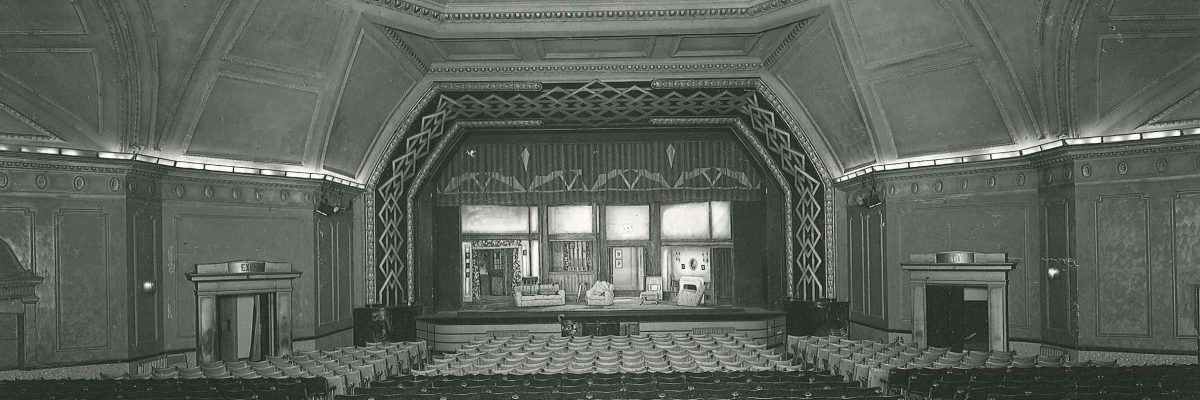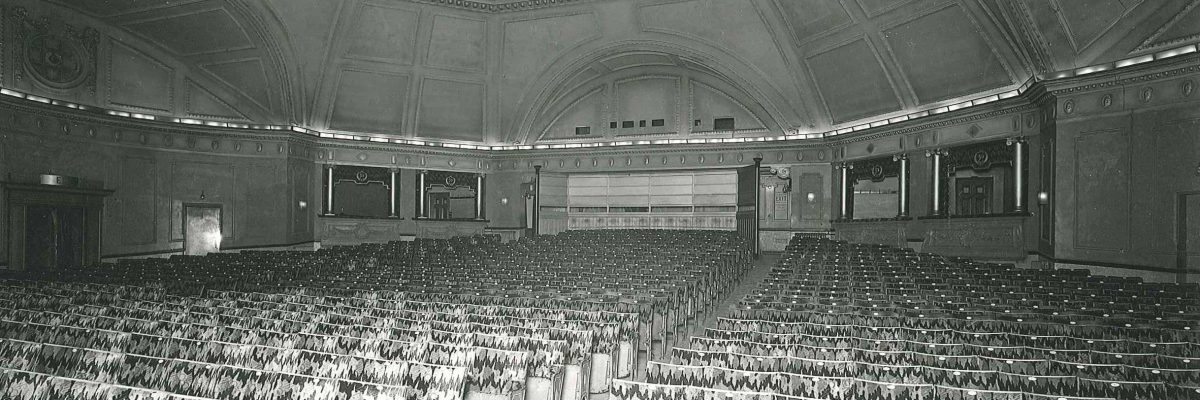Ghosts in the Connaught
Did you know that the Connaught Theatre is officially listed as having a ghost called The Grey Lady who was spotted many years ago?
Like any long established Theatre we have several recorded ghostly observations; we’ve seen objects moved mysteriously, sandbags, bibles, mirrors and more eerily the sound of a piano playing. On one occasion, during WW2, a ghost was blamed for causing a lightning bar to fall into the audience.

The Grey Lady
Our first recorded sighting of one of the Connaught’s Ghosts was not until 1974 when there were reports of a grey lady seen in two of these dressing rooms. The Worthing Gazette in July of that year credits a twenty year Old Middlesex Polytechnic student, who had a ‘walk-on’ part in the current production, as seeing ‘a grey lady with a white face and something on her head, vanishing into the wall’.
The eyewitness, Angelica Clayton, supported by a girlfriend, added that the figure was moving past a rail of clothes, but was actually above the rail. With her interest in history, she was able to date the costume to the Elizabethan period.
The second sighting of the grey lady was in August 1987 when fifteen year-old Joseph Hall, spending his summer holidays at the theatre as a trainee, came down here to fetch something & ran into her on the spiral staircase. Panicked he did not stop to study her more closely, but was able to describe her as Victorian.
Stage manager, Stephen Holroyd, accepts that Joseph saw what he claims. ‘He shot up the stairs, white as a sheet. You always get a chilly feeling near the bottom of the spiral staircase. Now, no one wants to work at night alone.’

Theatre Ghosts
by Roy Harley Lewis, published by David and Charles, 1988
The Connaught Theatre, Worthing, closed in January 1986 to a depressingly uncertain future, but fortunately for the town (and a drama-impoverished South Coast) re-opened nine months later, following a comprehensive £250,000 ’face-lift’. However, the new staff knew nothing about the theatre’s history, or its supernatural reputation. Even though I was able to recruit the assistance of local psychic investigator, Charles Walker, the results of our efforts were still to prove inconclusive. I can only hope that someone will turn up further evidence in the future.
Several theatre people had referred me to ’the ghost at Worthing’, but the first recorded sighting was not until 1974 when there were reports of a grey lady seen in two of the dressing rooms. An account in the Worthing Gazette in July of that year credits a twenty-year-old Middlesex Polytechnic student, who had a ’walk on’ part in the current production, as seeing ’a grey lady with a white face and something on her head, vanishing into the wall’. The eye- witness, Angelica Clayton, supported by a girl friend, added that the figure was moving past a rail of clothes, but was actually above the rail. With her interest in history, she was able to date the costume to the Elizabethan period.
However, when Charles Walker heard of the incident and visited the theatre he found another witness who said that the ghost had been behind the rail, but because of the height of the rail would appear to have been walking on a different floor level. Charles had taken along a selection of costume designs from different periods, and his witness identified the clothing as Victorian. ‘I suspect the student was influenced by being interested in a particular period,’ he speculated.
In fact, we shall never know because thirteen years later neither of us has been able to locate her. Nor has it been possible to establish if there was any building on the site, or in the immediate vicinity of where the Picturedrome was built, which might have given some clue to the ghost’s identity.
The second sighting was in August 1987 when the late Joseph Hall, then a fifteen-year-old, spending his summer holiday at the theatre as a trainee, went underneath the stage to fetch something – and ran into the ghost of the spiral staircase. The young man panicked and did not stop to study her more closely, but was able to describe her as ’Victorian’. Stage manager, Stephen Holroyd, accepts that Joseph saw what he claims. ‘He shot up the stairs, white as a sheet. You always get a chilly feeling near the bottom of the spiral staircase. Now, no one wants to work at night alone.’
Another local newspaper also reported the sounds of a piano playing by itself in another part of the complex but the witness remained remarkably elusive when I tried to confirm this, so I must remain sceptical on that score.
From the Connaught programme for The Haunted Hotel by Wilkie Collins
Most people speculate about ghosts at one time or another; since we all have to die, the fascination with death is as natural as it is inevitable. And human nature being what it is, the more bizarre the circumstances of death, the more they grip the imagination. Yet in theatre, exclusively, it is the setting that captures and holds our attention, because theatre ghosts represent a slice of drama that is larger than life – and death.
Rife with superstition, the playhouse provides an environment in which we are encouraged to suspend reality; where every effort is made to attain the air of ’magic’ conjured up by the ’live’ performance. Obviously, for much the same reason, a substantial number of rumoured sightings must be attributed to figments of such heightened imagination, or even wishful thinking. Yet, the majority of established ’resident’ ghosts cannot be shrugged off lightly. If only a quarter of the reports were to survive the most thorough evaluation, they would provide more than enough evidence of a special relationship between theatre and the supernatural.
Since the publication of Mr Lewis’ book Stephen Holroyd became Theatre Manager. He has made a number of interesting observations to substantiate his convictions about the “grey lady” without ever seeing her himself.
In particular, a few years ago the cast of GUY & AND DOLLS on a lark stayed overnight in the theatre. Among other ‘experiments’ they each drew an image of the ghost without reference to each other’s drawings. There was apparently, a remarkable concurrence in images of the ‘grey lady.’ They also tried to find the ghost instinctually. Whatever their success in these high jinks, – and granted the delusive powers of auto-suggestion, Mr Holroyd remains convinced it had much to do with the ill feelings among the company that followed. So much so in fact, that a known white witch was later asked to speak to the ghost, and claims he did, with resultant benign consequences.
Another interesting, though possibly irrelevant point to note, is that lay-lines travel directly through the front entrance of the Connaught, which some claim is as influential on the fortunes of the theatre as local subsidy!
